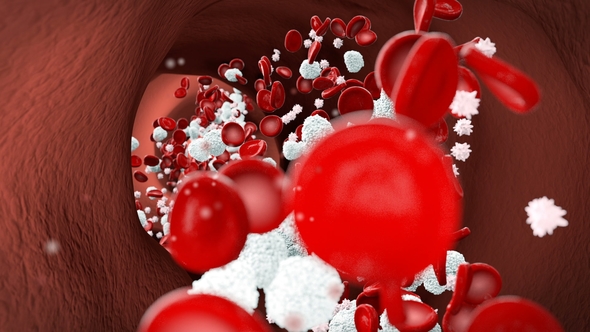In the article, we will consider how the leukocyte formula is calculated.
The leukocyte formula (aka leukogram) is the ratio in percent of different types of leukocytes, which is determined by counting them under a microscope in a stained blood smear.
A blood test for white blood cell count can be done in almost every medical institution. The result will be a form issued to the patient, indicating the indicators obtained and the limits of the norm inherent in his age category.
What is a leukocyte count in a blood smear and why is it needed?
Definition, general information
White blood cells, like other blood cells, form in the bone marrow. Their main function is the fight against infection and the response to tissue damage.
Unlike red blood cells, whose population is homogeneous, five types are distinguished in leukocytes, which differ in their functions and appearance: basophils, neutrophils, eosinophils, monocytes and lymphocytes.
White blood cells are formed from stem cells of the brain of the head. They do not live long, therefore they are constantly updated. The production of white blood cells in the bone marrow increases in response to any tissue damage, this is part of the usual inflammatory response. Different types of leukocytes have their own functions, but they can interact in a coordinated manner, contacting with the use of certain components - cytokines.
For a long time, a manual leukocyte count was performed.
High accuracy results
Modern analyzers make it possible to study blood with higher accuracy in an automatic mode (the specialist looks at one hundred or two hundred cells, while the device looks at several thousand). When determining by the apparatus for counting the leukocyte formula of atypical cell forms or determining significant deviations from the reference values, the leukocyte formula can be supplemented with a microscopic analysis of a blood smear, which allows diagnosing a number of pathologies, such as infectious mononucleosis, determining the severity of the infection process, determining the type of diagnosed atypical cells with leukemia. Human help is only needed when identifying errors in order to double-check the result of counting the leukocyte formula.
This approach greatly simplifies the procedure, but, unfortunately, at present not all laboratories have the necessary equipment.
WBC counting methods
Depending on the density, leukocytes are unevenly distributed in smears: close to the edges, eosinophils, basophils and neutrophils on the periphery; closer to the center are lymphocytes and monocytes.
When calculating the leukocyte formula, they use the Schilling method or the Filippchenko method.
The Schilling method determines the number of leukocytes in four areas of the smear. This is a four-field method. A total of one hundred and two hundred cells are counted in a smear.
The essence of Filippchenko’s leukocyte counting method is that mentally the smear is divided into three parts, such as initial, final and middle (three-field method). Count in a straight line from one edge of the smear across it to the other. The same number of cells is counted in each part. Only one hundred and two hundred white blood cells are taken into account. The found cells are entered into the Egorov grid - a special differential counting table. For a more convenient and quick determination of the leukocyte formula, a special eleven-key counter is used. Leukocyte counting techniques are constantly being improved.
Leukocyte analysis
The use of leukocyte counts in a blood smear for the accurate diagnosis of pathologies is quite difficult, because with different inflammatory processes in the body, the particle ratio is often similar. Typically, the information obtained is used to track the dynamics of the disease and the degree of effectiveness of therapy. Preparation for blood sampling for the study is not too complicated - a person only needs to give up food at least four hours before the analysis, and on the eve it is advisable to avoid strong emotional and physical stress.
To determine the leukocyte formula, venous blood acts as a material. Before the procedure, the laboratory assistant presses the patient’s forearm with a special strap, then inserts a thin needle into the vein at the elbow, the blood through which flows directly into the test tube. Then a drop of the obtained material is transferred to a glass plate in order to calculate the ratio of leukocytes and their number by means of a microscope. If the clinic has modern equipment, particles are considered a special analyzer, and the need for human intervention arises only when the result reflects strong deviations from the norm or the presence of abnormal particles. The obtained values can be evaluated by the attending physician.
Clinical significance
A leukogram in clinical practice is very important, because with any changes in the human body, the percentage concentration of certain types of white blood cells decreases or increases due to a decrease or increase in others to one degree or another. According to the leukocyte formula, we can draw conclusions about the course of the pathological process, the occurrence of complications and make a forecast of the outcome of the disease. The information of the leukogram should also be compared with the clinical symptoms of the pathology.
What is the decoding of a blood test with a white blood cell?
There are several criteria by which the state of the blood and the proportion of leukocytes will be evaluated by a specialist.
Leukocyte shift to the right or left
Of particular importance is the study in a blood smear of neutrophils. The doctor concludes that the rate of development or the presence of the disease is based not only on their quantity. The age of the cells also plays an important role, for example, the predominance of young neutrophils over more mature ones, and vice versa. The result of the analysis is therefore called a shift, because the recording of the blood formula obeys a certain order - first, young types of neutrophils are taken into account, then more mature cells in an increasing order. With the appearance of an imbalance, thus, there is a shift in indicators in one direction or another. If the number of young neutrophils is increased, they say a left shift of the leukocyte formula, which may indicate the presence of various pathological processes in the body. He talks about tissue necrotic processes, inflammation, infectious diseases, gas or food poisoning, as well as the consequences of taking various kinds of medicines. However, a left shift does not necessarily indicate pathology - there may be a temporary cellular imbalance after heavy physical exertion, which quickly returns to normal. The reverse situation - a shift to the right of the leukocyte formula - indicates the predominance of mature neutrophils in the blood. Such a distribution of white blood cells may indicate a deficiency of vitamin B 12 , radiation sickness, and kidney and liver diseases. A shift to the right is noted in people who have recently had a blood transfusion.

What does increased performance mean?
If the count of leukocyte counts in a blood test increases the number of neutrophils, this may indicate a large number of diseases and various specific conditions of a person. Such an effect can be noted with the appearance of infectious pathologies, including fungal origin (for example, candidiasis), an increase in blood glucose levels in diabetes, rheumatism, the presence of various cancer localization, poisoning with mercury or lead. A high content of neutrophils in the blood is also observed after severe pain, physical and emotional stress, as well as under the influence of extremely high or low temperatures.
Excessive lymphocyte count
If the norm of lymphocytes is exceeded, we can talk about the presence of an infectious disease, blood pathologies, arsenic or lead poisoning, as well as the result of the use of a number of drugs. After the patient has suffered an infectious disease, the content of monocytes in his blood rises. In addition, this state of blood is noted in people with malignant tumors, autoimmune diseases, and poisoning with phosphorus and tetrachloroethane.

It is interesting to note that leukocytes, before they die, can transmit a specific signal to nearby cells about the danger. This is the conclusion reached by Australian scientists who analyzed the behavior of cells through a special device that takes hundreds of shots per second. An increased content of eosinophils is noted in case of an allergic reaction to antibiotics, drugs for convulsive conditions and tuberculosis, parasitic invasion, a number of lung and skin diseases, acute course of infectious pathology. Tuberculosis, chickenpox, influenza - such diseases can cause an increase in the number of basophils in the blood.
In addition, the concentration of white blood cells of this type increases with ulcerative colitis, allergic reactions, as a result of high sensitivity to certain food products, can also indicate the presence of cancerous tumors in the body.
Decreased indicators and their significance
If the count of neutrophils is significantly reduced in the smear count, the specialist can diagnose an infectious disease (tuberculosis, typhoid fever), excessive sensitivity to drugs (anti-inflammatory and antihistamines, antibiotics), anaphylactic shock and anemia.
Lymphocytes have reduced leukocyte counts in acute inflammatory processes, immunodeficiency states of the body, systemic lupus erythematosus, and renal failure. In addition, an increase in particle concentration is characteristic of people who are exposed to x-ray radiation. Also, no less serious reasons can reduce the number of monocytes in a blood test. These include aplastic anemia, pyogenic infections and oncohematological pathologies. In addition, the effect in the form of a decrease in the content of monocytes can be caused by the use of certain drugs and the state of severe shock.
Decrease in concentration of eosinophils
You can diagnose the very beginning of the inflammatory process with a strong decrease in the concentration of eosinophils. This also happens with poisoning the body with heavy metals and the serious nature of a purulent infection. Severe stress, pregnancy and an ovulation period can be natural causes of a decrease in the content of basophils in the blood. Among the pathological causes are Cushing's syndrome and infectious diseases. The leukocyte formula allows a specialist to diagnose and monitor the degree of effectiveness of therapy for allergic reactions, various blood diseases, inflammations and other pathologies.
Conclusion
With such advantages as high accuracy, reproducibility and objectivity, the study can rightfully be considered one of the most indicative methods of blood analysis. The procedure cannot be carried out at home, so you should contact the laboratory to calculate the white blood cell count.
We examined how the count of the white blood cell count occurs.